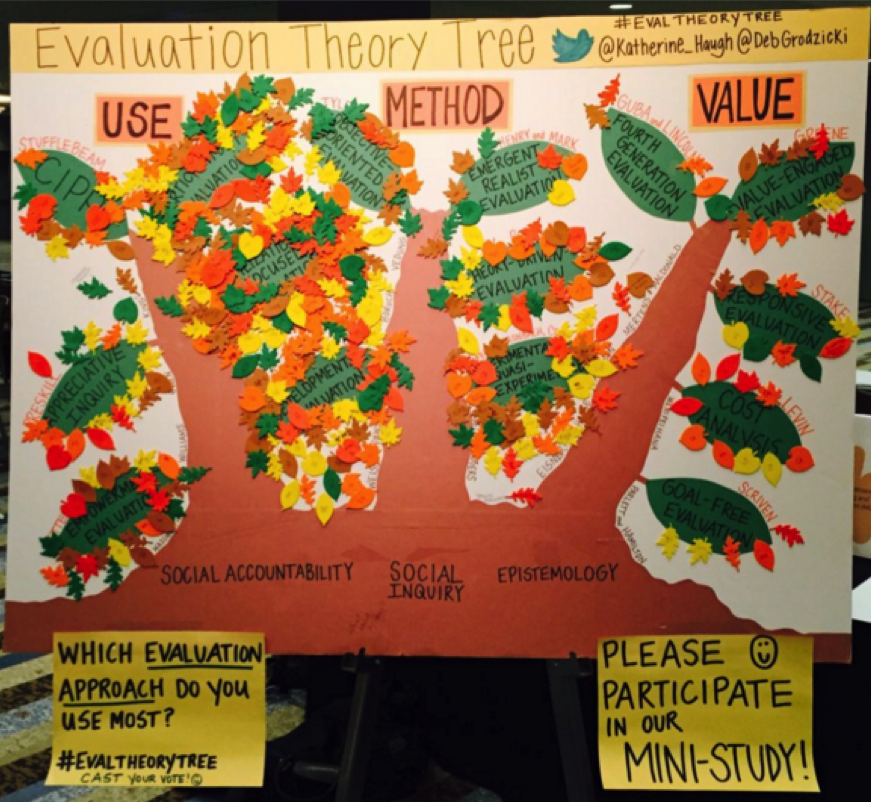Greetings evaluators! We are Katherine Haugh and Deborah Grodzicki from Innovation Network. At #Eval15 in the Windy City, we conducted a mini-study to try to understand which evaluation approaches evaluators at Evaluation 2015 use most frequently in their work. Drawing on Marvin C. Alkin’s Evaluation Roots: A Wider Perspective of Theorists’ Views and Influences, we re-created the evaluation theory tree to include major evaluation approaches (big green leaves) and evaluation theorists’ names. Take a look at our evaluation theory tree:
The mini-study collected real-time data by asking evaluators to stick a leaf next to the top two approaches they use most often in their work. For those who couldn’t make it to the conference but wanted to participate, we collected votes using #evaltheorytree on Twitter. We had a total of 390 votes and 195 participants. For those unfamiliar with the evaluation theory tree, here is our handout for further explanation and definitions of each evaluation approach.
Marvin C. Alkin and Tina Christie (2004) use the tree metaphor to visually depict foundations (“roots”) from which the field of evaluation emerged, and branches of theoretical work that have grown from these foundations. This study was prompted by our interest in understanding the extent to which these evaluation theories are understood and applied by the practicing community. We recognize that evaluation theorists, academics, and practitioners often work in silos, and for the field to evolve, efforts should be made to increase collaboration. We thought this mini-study would be a fun and creative way to bridge the gap between theory and practice.
What did we learn? (Drum roll, please.)
- The “use” branch stole the show. Take a look at the number of votes each evaluation approach received (out of total of 390 votes):
2. Some evaluators use approaches not included on the tree, such as interactive evaluation (2), transformative feminist evaluation (2), genuine evaluation (2), grounded theory (1), collaborative evaluation (1), and culturally responsive evaluation (1).
3. Several evaluators faced existential crises standing before our tree because they were unable to place themselves squarely within one or two approaches. Many commented that they often pull from multiple approaches within one evaluation, so selecting the approach they use most frequently was difficult.
We also we learned that comparing evaluation theories and approaches is useful for identifying and better understanding different perspectives within evaluation, as well as highlighting key debates among prominent theorists. Evaluation theory helps us discern the relative merits of evaluation approaches and improves our frame of reference when choosing an approach. For these reasons and others, we hope to continue bridging the gap between evaluation theory and practice!
We’d love to hear from you! Let’s keep the conversation going with #evaltheorythree or leaf (haha) your comments for us here.
Do you have questions, concerns, kudos, or content to extend this aea365 contribution? Please add them in the comments section for this post on the aea365 webpage so that we may enrich our community of practice. Would you like to submit an aea365 Tip? Please send a note of interest to aea365@eval.org . aea365 is sponsored by the American Evaluation Association and provides a Tip-a-Day by and for evaluators.



We did a similar exercise for one of our Atlanta-area Evaluation Association meetings. Easy, and a fun way to learn! You can see our version here: https://www.facebook.com/photo.php?fbid=10152496751184391&set=g.247717196175&type=1&theater
Glad I came across this again. We might have to do it again soon. Thanks!
As someone whose leaf is up there on that tree, I am delighted to see the results from your mini-study. I enjoyed the thought experiment as an evaluator and also the space it created in me to give some less-used approaches a second look for my own work.
Overall after working in the evaluation arena for 38 years I am in total agreement with the findings.